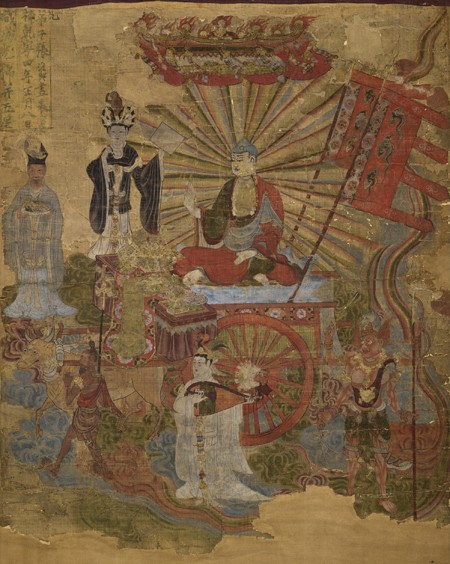From roughly the tenth to the fourteenth century, astral bodies gained unprecedented importance across what is now China, becoming increasingly a focus of empirical inquiry, literati poetics, religious devotion, divination, and mortuary practices. This development is documented in a broad range of materials, including rock-cut shrines, wall paintings, portable paintings and prints, and tomb sculptures. Surviving examples come from an equally extensive geographic and cultural range, encompassing the Han Chinese Song dynasty (960–1279) as well as neighboring states founded by the lesser-known, non-Han cultures of the Khitan Liao (907–1125) to the north and east, in present-day Manchuria and Inner Mongolia, and the Tangut Xixia (1038–1227) to the northwest.
Previous studies of this material have seldom strayed from readymade contextual categories—Buddhist, Daoist, official, or mortuary; exoteric or esoteric; Han Chinese or otherwise. My dissertation is the first study to treat astral materials across contexts from this period as a coherent visual and material culture. This is possible, and
First emerging as a personified incantation in Tang dynasty (618–907) sources, the Buddha Tejaprabhā had become, by the tenth century, the central figure of Buddhist astral deity worship in China and inner Asia. By some measures, he was a minor deity, surviving in only a few dozen representations and sutra manuscript copies across this vast territory. Yet despite their rarity, the materials of the Tejaprabhā cult tell a strikingly coherent story across time, place, and culture. I examine how Tejaprabhā paintings express not only a widespread desire to avoid astrological calamity caused, for example, by comets or inauspicious planetary movements but also larger, often implicit beliefs about the structure and continual transformation of the world. These materials record the synthesis of a distinctly Chinese Buddhist planetary cosmology, in which the center of the cosmos was not only occupied by the Buddha rather than exclusively by the emperor but was also untethered from any specific earthly territory or polity. Buddhist astrology’s potential to create new cosmological syntheses was most fully embraced by the Tangut Xixia state. The numerous extant paintings, prints, and other materials related to Tejaprabhā and his astral retinue from Tangut sites express a new world order, in which the theoretically totalizing Sinitic imperial vision became just one of many cosmological possibilities. They demonstrate, moreover, the importance of pictorial art in this period as a site of knowledge production.
To the east of Xixia in Liao territory, the longstanding tradition of painting “star maps” on tomb ceilings took a turn toward the divinatory and diagrammatic in the late eleventh-to mid-twelfth-century cemetery of a local elite Chinese family, the Zhang. Whereas in earlier tombs the planets and constellations were arrayed across a continuous field or sequenced within a single circular band, the tableaux in this cemetery combine depictions of up to five classes of astral objects—stars, planets, the sun and the moon, cyclical animals, and the Hellenistic zodiac signs—configured as concentric rings in a manner recalling bronze mirror design. Examining the correlative, topographic, and astrological logic behind the position and sequencing of each ring, I argue that these tableaux are pictorial analogues to popular
What is possibly the period’s most ambitious astral synthesis occurred in Xixia territory, in a mandala that survives from Kharakhoto, the repository in present-day Inner Mongolia that housed most of the period’s Tejaprabhā materials. This large silk painting attempts, somewhat unevenly, to assimilate in
